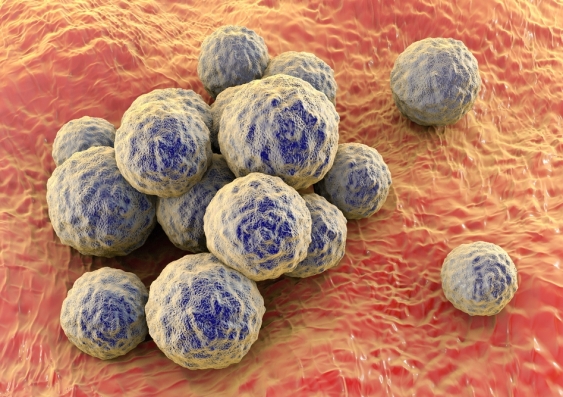创新背景
由于缺乏广泛捕获RNA相互作用的工具,金黄色葡萄球菌的这种适应系统一直没有被发现。在其他致病细菌中,相关技术依赖于特定蛋白质的存在,这些蛋白质似乎在金黄色葡萄球菌中不起作用。
创新过程
研究人员已经在金黄色葡萄球菌中发现了一个复杂的适应系统,识别和表征了多药耐药的机制,并为抗生素防御提供了新的防线。
包括新南威尔士大学生物技术和生物分子科学学院在内的一个国际研究团队应用了一种有前途的新工具——CLASH——在一种耐多药金黄色葡萄球菌(MRSA)菌株中捕获了数百种尚未发现的基因调控机制。

新工具发现的500个机制是基于金黄色葡萄球菌的mRNA。这些新发现的信使rna通常只是作为制造蛋白质的指令,它们通过直接相互作用控制金黄色葡萄球菌中的其他基因——调节细菌自身的遗传信息和抗生素耐受性。
在这些发现的rna中,有一种机制可以使细菌的细胞壁变厚——这种变化在耐最后一线抗生素的MRSA临床菌株中很常见——可能为抗生素治疗找到新的靶点。根据CLASH数据,研究容人员发现,在金黄色葡萄球菌中,有543个调控mrna相互作用的证据。
信使rna负责读取DNA,并将信使rna的信息翻译成蛋白质,而金黄色葡萄球菌中的信使rna则承担着调节功能,通知其他信使rna的生成速度和生成过程。当一个基因(DNA)被转录成RNA时,会有一点点额外的序列从两边转录出来——就像鞋带的褶带一样——这些被称为“非翻译区”或utr,在金黄色葡萄球菌中,正是这些信使rna的utr发挥着调节作用。
一个典型的UTR有40到50个碱基长,金黄色葡萄球菌中大约三分之一的UTR有100个碱基长,这是很长的。这可能为基因调控增加了一个全新的层面。

研究中使用的特殊金黄色葡萄球菌菌株取自一名MRSA败血症患者,该患者使用新研究的“最后防线”和抗生素万古霉素治疗了42天。由于金黄色葡萄球菌不是从其他金黄色葡萄球菌那里获得万古霉素耐受性,而是通过一系列突变进化而来,因此研究人员利用CLASH分析了这种菌株,以了解它们是如何变得对万古霉素耐受性的。
研究人员发现的其中一个mRNA UTRs是一种调节RNA,它促进一种参与细胞壁增厚的酶。这种增厚与耐万古霉素金黄色葡萄球菌一致。在金黄色葡萄球菌中有超过500个mRNA-mRNA相互作用的证据——这是由冲突发现的信息,这使研究人员能够将金黄色葡萄球菌中的许多调控rna的功能归因于它们。
创新关键点
研究人员已经在金黄色葡萄球菌中发现了一个复杂的适应系统,识别和表征了多药耐药的机制,并为抗生素防御提供了新的防线。
包括新南威尔士大学生物技术和生物分子科学学院在内的一个国际研究团队应用了一种有前途的新工具——CLASH——在一种耐多药金黄色葡萄球菌(MRSA)菌株中捕获了数百种尚未发现的基因调控机制。
创新价值
“超级细菌”,耐多药金黄色葡萄球菌是医疗保健和社区环境中的主要问题。MRSA败血症的治疗方案——进入血液的感染——仅限于最后一线抗生素,选择的治疗方法是万古霉素。
万古霉素是一种抗生素,可以阻断金黄色葡萄球菌中新细胞壁的组装。如果细菌在分裂过程中不能形成新的细胞壁,它就会爆炸。那些耐受万古霉素的金黄色葡萄球菌具有更厚的细胞壁,可能限制了细胞壁合成部位的抗生素。
通过揭示与金黄色葡萄球菌对万古霉素耐受性有关的一种机制(即以前未观察到的mrna正在增加细胞壁厚度),研究人员现在有机会利用这种机制,使耐药的金黄色葡萄球菌再次对万古霉素“增敏”。
The novel tool "CLASH" can capture undiscovered gene regulatory mechanisms in MRSA strains
Researchers have identified a complex adaptive system in Staphylococcus aureus that identifies and characterizes mechanisms of multidrug resistance and provides a new line of antibiotic defense.
An international team of researchers, including the University of New South Wales School of Biotechnology and Biomolecular Sciences, applied a promising new tool - CLASH - to capture hundreds of previously undiscovered gene regulatory mechanisms in a multi-drug resistant Staphylococcus aureus (MRSA) strain.
The 500 mechanisms identified by the new tool are based on mrnas from Staphylococcus aureus. These newly discovered mrnas, which normally only act as instructions to make proteins, control other genes in Staphylococcus aureus through direct interactions - regulating the bacteria's own genetic information and antibiotic tolerance.
Among the Rnas found is a mechanism that thickens the cell wall of bacteria - a change common in clinical strains of MRSA resistant to last-line antibiotics - that could find new targets for antibiotic therapy. Based on the CLASH data, the researchers found evidence for 543 regulatory mrna interactions in S. aureus.
Mrnas are responsible for reading DNA and translating mrna information into proteins, while mrnas in S. aureus are responsible for regulating how fast and how other mrnas are being made. When a gene (DNA) is transcribed into RNA, a little extra sequence is transcribed from both sides -- like the folds of a shoelace -- and these are called "untranslated regions" or UTRs, and in S. aureus, it is the UTRs of these messenger Rnas that play a regulatory role.
A typical UTR is 40 to 50 bases long, and about a third of the UTRs in S. aureus are 100 bases long, which is very long. This may add a whole new dimension to gene regulation.
The particular strain of Staphylococcus aureus used in the study was obtained from a patient with MRSA sepsis who was treated with the new study's "last line of defense" and the antibiotic vancomycin for 42 days. Because S. aureus did not acquire vancomycin tolerance from other S. aureus but evolved through a series of mutations, the researchers analyzed the strains using CLASH to understand how they became vancomycin resistant.
One of the mrnas identified by the researchers, UTRs, is a regulatory RNA that promotes an enzyme involved in cell wall thickening. This thickening is consistent with vancomycin-resistant Staphylococcus aureus. There is more than 500 evidence of mrNA-mrna interactions in S. aureus - information found by conflict, which has allowed researchers to attribute many of the functions of regulatory Rnas in S. aureus to them.
智能推荐
生物医学工程创新 | 利用CRISPR标记可将干细胞转化为所需细胞类型
2022-09-30杜克大学的一个生物医学工程师团队通过掌握基因调节网络的语言,创造了一种将干细胞转化为所需细胞类型的新方法。
涉及学科涉及领域研究方向生物医学工程创新 | 创新利用纳米颗粒可有效检测血液样本中超低水平microRNA
2022-09-30新南威尔士大学的研究人员发现了一种利用纳米颗粒检测血液样本中超低水平microRNA的新方法,可以使癌症和其他疾病的诊断更快,更有效。
涉及学科涉及领域研究方向细胞学创新 | 应用新型全息系统可捕捉到细胞的高速运动并进行成像
2022-09-28杜克大学的生物医学工程师设计了一种全息系统,该系统能够每分钟成像和分析数以万计的细胞,从而发现并识别疾病的迹象。
涉及学科涉及领域研究方向生物医学新材料 | 创新利用“冷冻丝绸”帮助修复受损心脏
2022-09-29生物医学工程师在完善了一种制造能促进心脏干细胞生长的生物材料的方法后,朝着为受损心脏开发心脏补丁的目标又迈进了一步。
涉及学科涉及领域研究方向